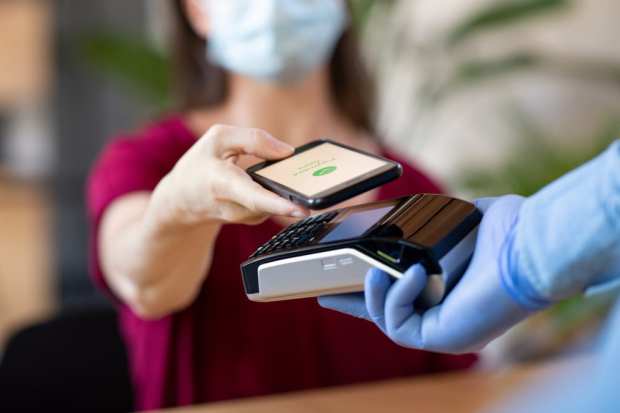How Retailers Can Ride The Rise Of Mobile Wallets

Mobile payments have long been billed as the next big thing. Starting with the release of Apple Pay in 2014, there was a veritable rush of proprietary mobile wallets sent to market, a host of “… Pays” for consumers to choose from.
The problem, Brett Narlinger, Blackhawk Network’s head of global commerce, told Karen Webster, is that most consumers weren’t really looking for a new payments form factor that they could only use on certain devices or at a short list of places. In the pre-pandemic world, mobile wallets struggled to get all the way up to a 1 percent penetration rate among consumers.
Then the pandemic happened, Narlinger noted, and the world turned upside-down overnight. Consumers were suddenly doing the majority of their shopping digitally — and when shopping in-store, they had access to touchless payments that didn’t require them to lay hands on a public keypad. Mobile wallets and mobile payments have jumped from a “cool idea” to a necessity for preserving consumers’ safety and comfort with the entire shopping process — which, in turn, has ignited interest across the commerce landscape.
“All of a sudden, we’re seeing players jump in to say: ‘Hey, we think there’s an opportunity to play in this space,’” Narlinger said. “And in many places, for the first time, our retailers are open to it. They’re seeing this as an opportunity to change and shift.”
But although they want mobile, they aren’t looking for the 1.0 version embodied by the Apple and Google Pays of the world. The current shift has created a new arena of opportunity for Blackhawk to enter the payments space, leveraging the barcode technology it has been working with since its founding in the world of gift cards to create new mobile wallet options, which enable consumers to spend their stored value at the point of sale.
“Someone asked me a couple of weeks ago, ‘why is Blackhawk in the payments game now?’” Narlinger said. “And I said, ‘well, funny enough, the puck went right to us.’”
Right to them — and to firms like Venmo, with which Blackhawk is now partnering to give merchants and consumers access to a new set of payment rails that use barcode technology merchants already know and understand, as an entry point to various silos of stored digital value that consumers might want to tap as a payment method.
Unlocking Stored Value
Narlinger said that stored value exists all over the commerce landscape — in rewards or loyalty accounts currently holding points, frequent flyer miles or stars … or in Venmo wallets in the form of funds moved between friends. The problem with all of that value, he explained, is that it’s essentially all locked up. The customer has it, but can only access or use it in very narrow circumstances.
But under present conditions, Narlinger noted, that lock-up isn’t really workable. In the current economic uncertainty, consumers are looking for more flexibility in how they spend funds, and maximizing control and flexibility are high-priority goals. That has put pressure on firms with all kinds of stored value to start “coming out of the woodwork” with the same request for Blackhawk, said Narlinger. They want to build a mobile wallet, but not like the ones of the past that acted as repositories for credit and debit card information.
“They want new wallet options that [enable consumers to spend stored value] at the POS,” he said. “What we’re hearing is: ‘Hey, we have this stored value. Can we unpack it?’ And the answer is, “Yes, a bar code can give you a way to do that — and in a form that retailers already understand how to accept.”
From the merchant’s point of view, the transaction process is nearly identical to the one to which they’re already accustomed. A consumer scans an item, Blackhawk verifies that there are adequate funds to cover it and then authorizes the transaction. The purchase settles the same way as any payment would, utilizing the same rails Blackhawk would use for a sale paid for with a gift card.
“It’s just a retailer doing a transaction through a different account with less expensive rails,” Narlinger said — one that doesn’t require any additional technological integration for the merchant, and provides a lot more flexibility and control for the consumers.
The Changing Payments Paradigm
The capability to export value from a variety of sources to use at the point of sale is a big leap forward — but is still in itself a first step, Narlinger noted. The next challenge retailers must consider as they head into the post-pandemic period is how to entice consumers into finding value in actually using those mobile wallets.
“In the first round, the issue is: ‘The consumer has value — how do you uncap it?’” he said. “The next step is: ‘How do you move to that wallet being a preferred [payment] source?'”
Narlinger said that in many ways, opening that up to the payments world will mean creating a retail experience that looks a bit like financial services’ journey to a flexible and enticing consumer proposition. The winning offer will ultimately be choice. The providers who walk away as the big winners will be the ones that figure out how to take those mobile experiences and then layer in loyalty, rewards and user convenience.
Because even when a vaccine brings the pandemic to an end — whether that’s three months, six months or a year-and-a-half from now — Narlinger doubts that consumers will go back to who they were six months ago.
“We [consumers] are looking at brands differently. We’re looking at gifts differently. We’re looking at shopping journeys differently, end to end,” he said. “I think we’ve passed an inflection point when it comes to how consumers will want to manage their commerce lives going forward.”
